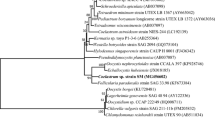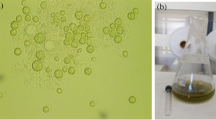Abstract
The feasibility of microalgae cultivation using cooking cocoon wastewater (CCW) collected from a silk production factory was investigated in this work. Results showed that Chlorella sorokiniana grew well on the CCW whether it was autoclaved or not. After 7-day cultivation, the biomass increased by 1.57, 2.78, 3.33, and 3.14 times, and by 3.65, 4.03, 3.27, and 2.82 times when this alga was cultivated in the raw CCW (R-CCW) and autoclaved CCW (A-CCW) at the initial dry cell densities of 0.01, 0.04, 0.08, and 0.16 g/L, respectively. The algal photosynthetic growth was not affected when this alga grew on the R-CCW at an initial dry cell density of ≥ 0.04 g/L, while it was significantly inhibited when the initial dry cell density was 0.01 g/L. Additionally, this alga could remove nutrients rapidly from the CCW, and the removal efficiency increased with the increase of initial dry cell density. Thus, it was concluded that the CCW could be used as a good-quality medium for the algal growth, which is worthy of further study and promotion.



Similar content being viewed by others
References
Fazal, T., Mushtaq, A., Rehman, F., Ullah Khan, A., Rashid, N., Farooq, W., Rehman, M. S. U., & Xu, J. (2018). Bioremediation of textile wastewater and successive biodiesel production using microalgae. Renewable and Sustainable Energy Reviews, 82, 3107–3126.
Sathasivam, R., Radhakrishnan, R., Hashem, A., & Abd_Allah, E. F. (2017). Microalgae metabolites: a rich source for food and medicine. Saudi Journal of Biological Sciences. https://doi.org/10.1016/j.sjbs.2017.11.003.
Rastogi, R. P., Pandey, A., Larroche, C., & Madamwar, D. (2017). Algal green energy – R&D and technological perspectives for biodiesel production. Renewable and Sustainable Energy Reviews, 82, 2946–2969.
Pleissner, D., & Rumpold, B. A. (2018). Utilization of organic residues using heterotrophic microalgae and insects. Waste Management, 72, 227–239.
Yang, J., Xu, M., Zhang, X., Hu, Q., Sommerfeld, M., & Chen, Y. (2011). Life-cycle analysis on biodiesel production from microalgae: water footprint and nutrients balance. Bioresource Technology, 102(1), 159–165.
Zhou, W., Chen, P., Min, M., Ma, X., Wang, J., Griffith, R., Hussain, F., Peng, P., Xie, Q., Li, Y., Shi, J., Meng, J., & Ruan, R. (2014). Environment-enhancing algal biofuel production using wastewaters. Renewable and Sustainable Energy Reviews, 36, 256–269.
Guldhe, A., Kumari, S., Ramanna, L., Ramsundar, P., Singh, P., Rawat, I., & Bux, F. (2017). Prospects, recent advancements and challenges of different wastewater streams for microalgal cultivation. Journal of Environmental Management, 203(Pt 1), 299–315.
He, P. J., Mao, B., Shen, C. M., Shao, L. M., Lee, D. J., & Chang, J. S. (2013). Cultivation of Chlorella vulgaris on wastewater containing high levels of ammonia for biodiesel production. Bioresource Technology, 129, 177–181.
Mujtaba, G., & Lee, K. (2017). Treatment of real wastewater using co-culture of immobilized Chlorella vulgaris and suspended activated sludge. Water Research, 120, 174–184.
Udaiyappan, A. F. M., Hasan, H. A., Takriff, M. S., & Abdullah, S. R. S. (2017). A review of the potentials, challenges and current status of microalgae biomass applications in industrial wastewater treatment. Journal of Water Process Engineering, 20, 8–21.
Chung, Y. S., Lee, J. W., & Chung, C. H. (2017). Molecular challenges in microalgae towards cost-effective production of quality biodiesel. Renewable and Sustainable Energy Reviews, 74, 139–144.
Quijano, G., Arcila, J. S., & Buitrón, G. (2017). Microalgal-bacterial aggregates: applications and perspectives for wastewater treatment. Biotechnology Advances, 35(6), 772–781.
Capar, G., Aygun, S. S., & Gecit, M. R. (2008). Treatment of silk production wastewaters by membrane processes for sericin recovery. Journal of Membrane Science, 325(2), 920–931.
Wu, J. H., Wang, Z., & Xu, S. Y. (2007). Preparation and characterization of sericin powder extracted from silk industry wastewater. Food Chemistry, 103(4), 1255–1262.
Zhang, Y. Q. (2002). Applications of natural silk protein sericin in biomaterials. Biotechnology Advances, 20(2), 91–100.
Li, Y., Chen, Y. F., Chen, P., Min, M., Zhou, W., Martinez, B., Zhu, J., & Ruan, R. (2011). Characterization of a microalga Chlorella sp. well adapted to highly concentrated municipal wastewater for nutrient removal and biodiesel production. Bioresource Technology, 102(8), 5138–5144.
Miazek, K., & Ledakowicz, S. (2013). Chlorophyll extraction from leaves, needles and microalgae: a kinetic approach. International Journal of Agricultural and Biological Engineering, 6, 107–115.
Deng, X. Y., Gao, K., Zhang, R. C., Addy, M., Lu, Q., Ren, H. Y., Chen, P., Liu, Y. H., & Ruan, R. (2017). Growing Chlorella vulgaris on thermophilic anaerobic digestion swine manure for nutrient removal and biomass production. Bioresource Technology, 243, 417–425.
Deng, X. Y., Li, D., Wang, L., Hu, X. L., Cheng, J., & Gao, K. (2017). Potential toxicity of ionic liquid ([C12mim]BF4) on the growth and biochemical characteristics of a marine diatom Phaeodactylum tricornutum. Science of the Total Environment, 586, 675–684.
Ben-Amotz, A., Tornabene, T. G., & Thomas, W. H. (1985). Chemical profile of selected species of microalgae with emphasis on lipids. Journal of Phycology, 21, 72–81.
Cai, T., Park, S. Y., & Li, Y. (2013). Nutrient recovery from wastewater streams by microalgae: status and prospects. Renewable and Sustainable Energy Reviews, 19, 360–369.
Hena, S., Znad, H., Heong, K. T., & Judd, S. (2017). Dairy farm wastewater treatment and lipid accumulation by Arthrospira platensis. Water Research, 128, 267–277.
Park, J., Jin, H. F., Lim, B. R., Park, K. Y., & Lee, K. (2010). Ammonia removal from anaerobic digestion effluent of livestock waste using green alga Scenedesmus sp. Bioresource Technology, 101(22), 8649–8657.
Mujtaba, G., Rizwan, M., Kim, G., & Lee, K. (2018). Removal of nutrients and COD through co-culturing activated sludge and immobilized Chlorella vulgaris. Chemical Engineering Journal, 343, 155–162.
Wang, Y., Ho, S. H., Cheng, C. L., Nagarajan, D., Guo, W. Q., Lin, C., Li, S., Ren, N., & Chang, J. S. (2017). Nutrients and COD removal of swine wastewater with an isolated microalgal strain Neochloris aquatica CL-M1 accumulating high carbohydrate content used for biobutanol production. Bioresource Technology, 242, 7–14.
Paliwal, C., Mitra, M., Bhayani, K., Bharadwaj, S. V. V., Ghosh, T., Dubey, S., & Mishra, S. (2017). Abiotic stresses as tools for metabolites in microalgae. Bioresource Technology, 244(Pt 2), 1216–1226.
Alyabyev, A. J., Loseva, N. L., Gordon, L. K., Andreyeva, I. N., Rachimova, G. G., Tribunskih, V. I., Ponomareva, A. A., & Kemp, R. B. (2007). The effect of changes in salinity on the energy yielding processes of Chlorella vulgaris and Dunaliella maritima cells. Thermochimica Acta, 458(1-2), 65–70.
Aponasenko, A. D., Shchur, L. A., & Lopatin, V. N. (2007). Relationship of the chlorophyll content with the biomass and disperse structure of phytoplankton. Doklady Biological Sciences, 412(1), 61–63.
Cho, H. U., Kim, Y. M., & Park, J. M. (2017). Enhanced microalgal biomass and lipid production from a consortium of indigenous microalgae and bacteria present in municipal wastewater under gradually mixotrophic culture conditions. Bioresource Technology, 228, 290–297.
Rashid, N., Park, W. K., & Selvaratnam, T. (2018). Binary culture of microalgae as an integrated approach for enhanced biomass and metabolites productivity, wastewater treatment, and bioflocculation. Chemosphere, 194, 67–75.
Nam, K., Lee, H., Heo, S. W., Chang, Y. K., & Han, J. I. (2016). Cultivation of Chlorella vulgaris with swine wastewater and potential for algal biodiesel production. Journal of Applied Phycology, 29, 1171–1178.
Maxwell, K., & Johnson, G. N. (2000). Chlorophyll fluorescence—a practical guide. Journal of Experimental Botany, 51(345), 659–668.
Seyfabadi, J., Ramezanpour, Z., & Amini Khoeyi, Z. (2010). Protein, fatty acid, and pigment content of Chlorella vulgaris under different light regimes. Journal of Applied Phycology, 23, 721–726.
Álvarez-Díaz, P. D., Ruiz, J., Arbib, Z., Barragán, J., Garrido-Pérez, M. C., & Perales, J. A. (2017). Freshwater microalgae selection for simultaneous wastewater nutrient removal and lipid production. Algal Research, 24, 477–485.
Zhang, Y., Su, H., Zhong, Y., Zhang, C., Shen, Z., Sang, W., Yan, G., & Zhou, X. (2012). The effect of bacterial contamination on the heterotrophic cultivation of Chlorella pyrenoidosa in wastewater from the production of soybean products. Water Research, 46(17), 5509–5516.
Ma, X., Zhou, W., Fu, Z., Cheng, Y., Min, M., Liu, Y., Zhang, Y., Chen, P., & Ruan, R. (2014). Effect of wastewater-borne bacteria on algal growth and nutrients removal in wastewater-based algae cultivation system. Bioresource Technology, 167, 8–13.
Schmidt, J. J., Gagnon, G. A., & Jamieson, R. C. (2016). Microalgae growth and phosphorus uptake in wastewater under simulated cold region conditions. Ecological Engineering, 95, 588–593.
Su, Y., Mennerich, A., & Urban, B. (2012). Synergistic cooperation between wastewater-born algae and activated sludge for wastewater treatment: influence of algae and sludge inoculation ratios. Bioresource Technology, 105, 67–73.
Zemke-White, W. L., Clements, K. D., & Harris, P. J. (2000). Acid lysis of macroalgae by marine herbivorous fishes: effects of acid pH on cell wall porosity. Journal of Experimental Marine Biology and Ecology, 245(1), 57–68.
González, C., Marciniak, J., Villaverde, S., García-Encina, P. A., & Muñoz, R. (2008). Microalgae-based processes for the biodegradation of pretreated piggery wastewaters. Applied Microbiology and Biotechnology, 80(5), 891–898.
Zhu, L. (2015). Biorefinery as a promising approach to promote microalgae industry: an innovative framework. Renewable and Sustainable Energy Reviews, 41, 1376–1384.
Ren, X., Chen, J., Deschênes, J. S., Tremblay, R., & Jolicoeur, M. (2016). Glucose feeding recalibrates carbon flux distribution and favours lipid accumulation in Chlorella protothecoides through cell energetic management. Algal Research, 14, 83–91.
Wang, L., Li, Y., Sommerfeld, M., & Hu, Q. (2013). A flexible culture process for production of the green microalga Scenedesmus dimorphus rich in protein, carbohydrate or lipid. Bioresource Technology, 129, 289–295.
Funding
This manuscript was supported by the Project of “Six Talent Peak” of Jiangsu Province (SWYY-025), the Qinglan Project of Jiangsu Province (2016), the Shenlan Project of Jiangsu University of Science and Technology (2015), and the China Scholarship Council (Grant No. 201802180064).
Author information
Authors and Affiliations
Corresponding author
Ethics declarations
Conflict of Interest
The authors declare that they have no conflict of interest.
Ethical Statement
The authors declare that there are no studies conducted with human participants or animals.
Additional information
Publisher’s Note
Springer Nature remains neutral with regard to jurisdictional claims in published maps and institutional affiliations.
Rights and permissions
About this article
Cite this article
Li, D., Amoah, P.K., Chen, B. et al. Feasibility of Growing Chlorella sorokiniana on Cooking Cocoon Wastewater for Biomass Production and Nutrient Removal. Appl Biochem Biotechnol 188, 663–676 (2019). https://doi.org/10.1007/s12010-018-02942-7
Received:
Accepted:
Published:
Issue Date:
DOI: https://doi.org/10.1007/s12010-018-02942-7




